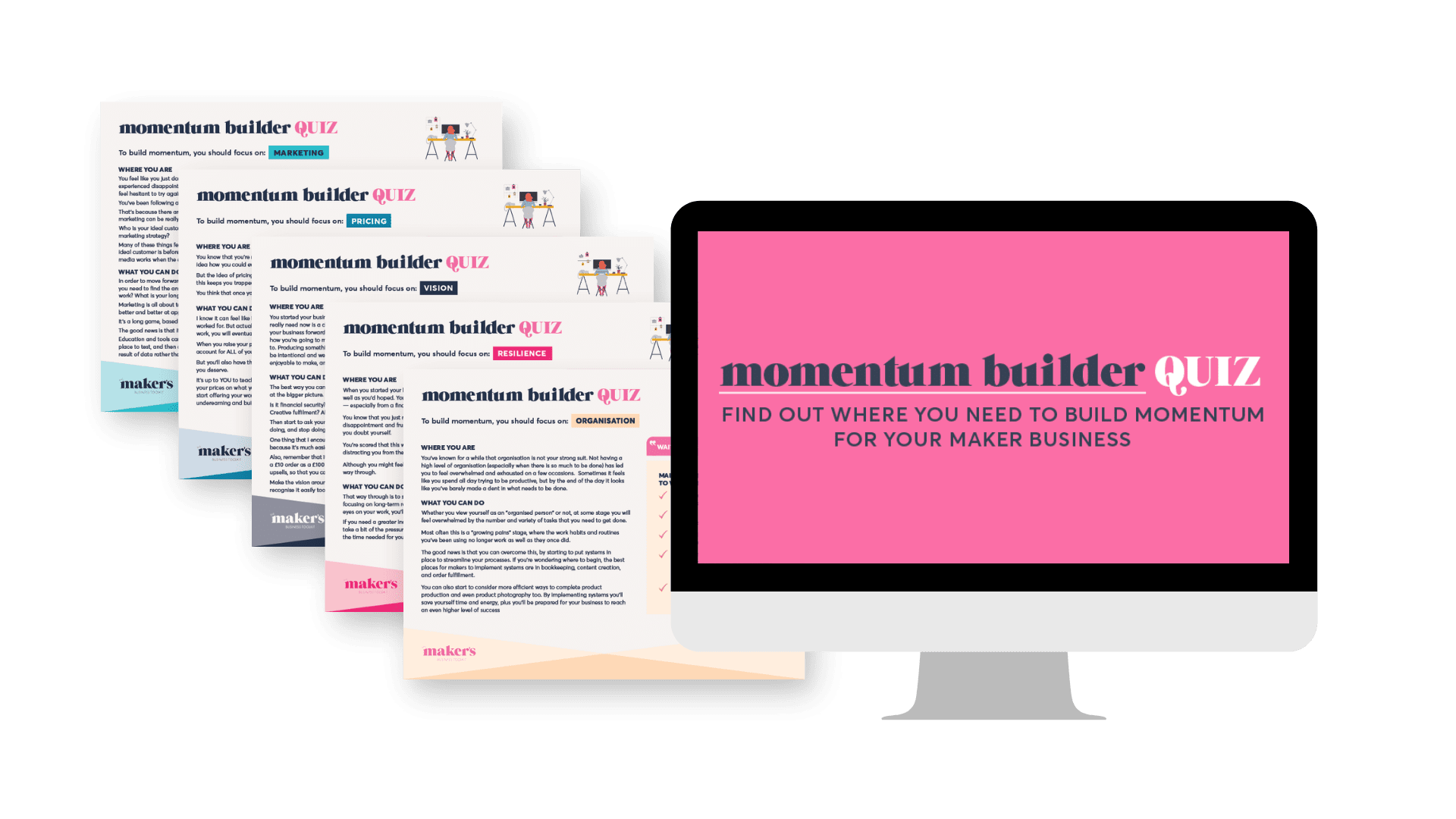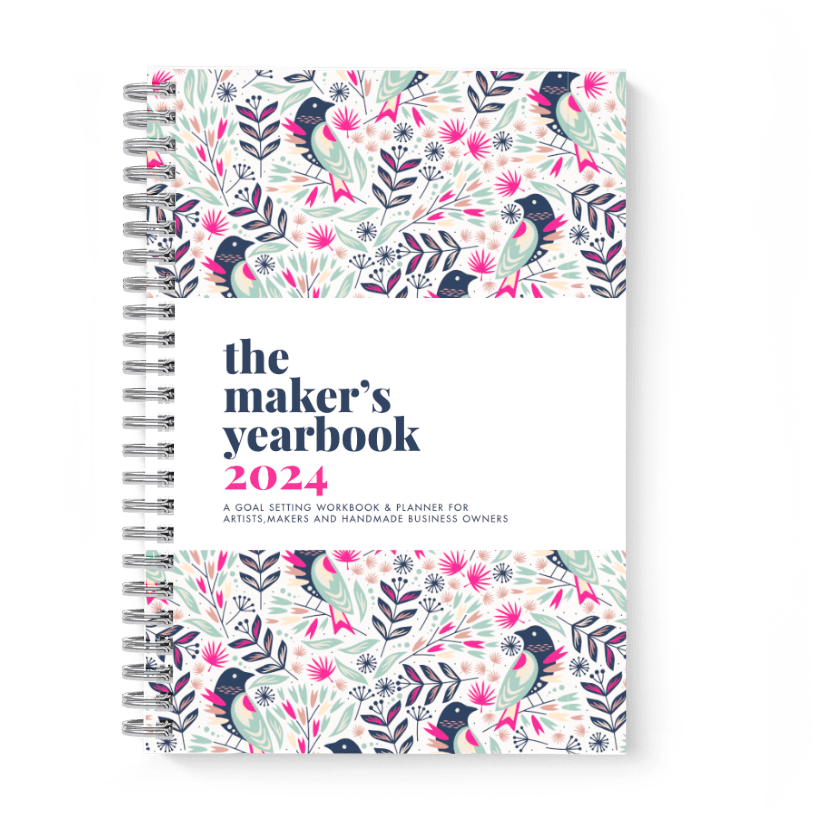I get it. It’s tempting to rely on Etsy or your Facebook shop to sell your art. It’s easy to set up and free (apart from the associated fees when you sell your work).
But every single artist should also have a website. Even better if you can sell your art from your website too. Why? Well, actually, there are many reasons!
1. Brand recognition
When people buy from Etsy, and someone asks them, ‘That’s a beautiful piece of art – where did you get it from?’, what do you think they say?
Your business name? Or Etsy?
Unfortunately, it’s the latter.
In fact, some people won’t even know the name of the artist when they buy off Etsy. That means you have no way of building your brand and attracting repeat customers. All you’re doing is, well, promoting Etsy!
2. You can collect email addresses
When you rely on places like Etsy or Facebook, you’re not in control of these platforms. You can’t control where your art shows up in search results or how many people see your art.
When you have your own website, you’re in control. You can collect email addresses on your website easily and build a list of potential customers you can keep in constant contact with.
3. There’s a more favourable fee structure
Yes, there’s the initial cost with setting up a website, but long term, it could work out a lot cheaper to sell your art via your website rather than somewhere like Etsy.
In the UK, Etsy will charge you £0.20 to list each of your items. And they will charge you a 6.5% transaction fee.
That means if you sell a piece of art for £200.00, you’ll give Etsy £13.20.
It can work out much cheaper to sell your art over your website instead. There will be payment processing fees (such as PayPal fees) but you’d have to pay these even if you were selling via somewhere like Etsy too.
When you’re first starting out, Etsy’s payment fees may seem negligible, but as your business grows, they can really add up!
4. You have free rein over the web design
The big problem with relying on other companies to sell your artwork is you are limited to their design and branding.
Yes, you can add a bit of information about yourself, but it’s difficult to showcase who you are on another company’s website.
When you design your own website, you can design and brand it exactly how you like. Your website copy can reflect who you are and you can include as many pages as you like (such as an about page). It’s your little corner of the internet that you have full control over.
5. Your audience doesn’t get distracted
The problem with companies such as Etsy or Not On The High Street is that your art is not the only art on offer. (It would be lovely if they only featured yours, wouldn’t it?)
That means you’re competing against other artists. But on your own website, your art takes centre stage and there’s no competition.
Does this mean you should ONLY have a website?
Although, yes, I am a firm believer that you should have a website, that doesn’t mean you shouldn’t list your art on spaces like Etsy or Not On The High Street.
These are highly trafficked websites and are an ideal opportunity for you to find new customers. But having your own space is equally as important, especially for repeat customers who initially found you elsewhere.
The Best Website Builders for Artists Who Want to Sell Their Art on Their Website
We’ve now established that you should have your own website. Yes, they take some time to set up. Yes, there’s a learning curve with whatever website builder you use. And yes, you will have to invest some money upfront. But they are worth it in the long run.
Now for the next important question: how on earth do you build it? And how can you do it without spending too much time or money on it? After all, you didn’t get into business to become a web designer, right?
Below, I’ve listed my recommended website builders that will allow you to build a website relatively quickly and cheaply, and without much technical skill required.
1. Squarespace for artists
An overview of Squarespace
Squarespace is probably the most popular website builder for artists. The platform is aimed at creative businesses, and there are many templates for showcasing your creative products. It’s a great way to create a visually stunning website!
How much does Squarespace cost for artists?
If you want to sell your artwork on your website, then you can start with a business plan, which is £21 per month or £180 per year. This includes your domain name, hosting, template and e-commerce facilities to sell your art.
Ease of use
Squarespace is aimed at non-techie business owners who want to create a website quickly and easily.
You firstly choose a website template you like, then customise your website with different layouts, fonts, colours and imagery.
You cannot make your website EXACTLY how you want it – the templates aren’t fully customisable – not unless you know how to code.
But it’s my recommendation that you don’t get too bogged down with designing your website. Having an attractive, easy-to-use website that follows a template will still get you sales, whereas spending forever faffing around trying to make your website perfect will not!
Finally, you don’t have to worry about registering your domain name or getting separate hosting. When you sign up to Squarespace, it does all this for you.
How would I recommend Squarespace for artists?
*****
Five stars!
Squarespace is a little more pricey than other providers but well worth it for ease of use and the fact that it’s aimed at creative businesses.
2. Shopify for artists
An overview of Shopify
Shopify is an e-commerce platform, which means it helps you build websites that are designed to help you sell products online. The layout of a Shopify website tends to look more like a shopping site than, say, a service-based website.
Take my website as an example. I sell only one physical product (the Makers’ Yearbook), so I don’t require a full online shop. But if you’re selling a lot of art, you might do. That’s where Shopify comes in.
You might be thinking an online shop will look a bit bland and samey. But actually, many of the themes you can choose from on Shopify are highly attractive.
How much does Shopify cost for artists?
For many artists, the basic package available on Shopify is more than suitable. This costs £24 per month and includes your hosting and ability to sell your art online.
Shopify includes both paid and free themes, so you can create your website for very cheap if you choose a free theme.
Ease of use
Just like Squarespace, Shopify is aimed at non-techie business owners. It’s easy to set up and list your products.
You select a theme and then simply edit the colours, imagery, text and fonts as you wish. You can see the front end of the website as you’re editing it, which makes it much easier!
Shopify is an e-commerce platform, which means it has all the features you could possibly need to sell your art including entering the product weight for shipping purposes, adding variants for size or colour, adding quantities and easily printing shipping labels.
They also have an array of apps to choose from, once you’ve selected your theme. These include an Instagram feed (so you can add your Instagram images to your website) and the Pinterest app, which allows you to connect your Pinterest account to your Shopify store and encourage people to buy from you.
How would I recommend Shopify for artists?
****
Four stars!
Shopify is brilliant for artists with a lot of art to sell. It’s an e-commerce platform first and foremost and is there primarily to help you sell your products.
If you only have a few pieces of art, you may not need something as robust as Shopify (Squarespace might be better for you).
The support is excellent too. One thing I would say, though, is it is quite easy to overspend on the theme and the many apps, so do be careful. Make sure you set a budget before you set up your Shopify account.
Also, the reason I don’t think Shopify is quite as good as Squarespace is because of the limited blogging options.
Blogging allows you to get more search engine rankings (i.e. you are more likely to show up on the first page of Google’s search results) and therefore get more website traffic.
Shopify comes with an in-built blog, but it has limited features, whereas Squarespace allows you to showcase your blog across your entire website and categorise and tag your blogs so they can be easily found by your users.
Finally, even though you can do a lot with Shopify, there is a big learning curve to it, especially when integrating with so many different apps.
3. WordPress with Woocommerce for artists
An overview of WordPress
You may have heard of WordPress. It’s the most popular content management system in the world.
One of the best things about WordPress is that you have more control over the design of your website. And you can also decide where you host your website or get your domain name. This can be both a good and a bad thing. For those of you who aren’t technical, you might prefer Squarespace or Shopify because everything is done for you.
How much does WordPress cost for artists?
WordPress and Woocommerce are free; however, you will have to pay for your hosting, theme, domain name and security as an extra.
- Hosting can be £15 to £30 per month.
- Your domain name is typically £20 to £30 a year.
- A theme can be anything from £0 to £200+ depending on what you choose.
- And security could be £0 to £200 a year, depending on what option you choose.
It’s still cheaper to go with WordPress but not so much cheaper that it justifies using it over the other platforms.
Ease of use
I’m not saying you need to know how to code to use WordPress, but it is slightly more technical than Squarespace or Shopify.
Yes, there are themes which make things easier, but there’s still a steep learning curve, especially as you’ll have to learn two things – WordPress and Woocommerce – and have to navigate any problems that occur between the two platforms.
Plus, you’ll need to set up your own hosting and domain name separately too. And you’ll need to manage and update any plugins you install on your WordPress website, all of which will have separate developers you’ll need to contact in case you have any issues.
How would I recommend WordPress and Woocommerce for artists?
***
Three stars.
WordPress is a brilliant platform, but unless you’re quite technical (or enjoy that kind of thing) and want more control over how your website looks, I’d recommend Squarespace or Shopify instead.
WordPress is certainly cheaper, but you’ll spend a lot more time trying to understand what to do. If you encounter technical issues, you may have to pay for a developer to help you. There are some excellent WordPress developers; however, costs can vary drastically. Unfortunately, there are also some unreliable developers, who will blame other plugins, themes or page builders for issues you experience.
What are your next steps?
You’ll now have an idea of which platform is best to use for your new website.
But as exciting as a brand-new website is, unfortunately, a website on its own won’t lead to sales.
You’ll need to know how to drive traffic to your website and how to convert that traffic into paying customers.
This is where the Makers’ Momentum Club comes in.
Makers’ Momentum Club helps artists, makers and craftspeople find more customers, create a consistent income and build a profitable business. You can learn more about the club here.








